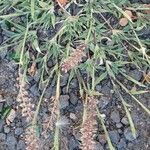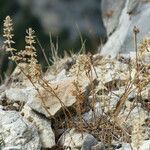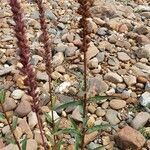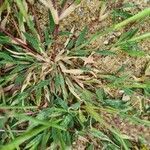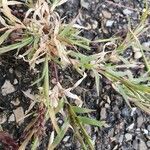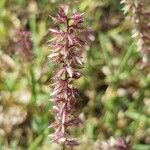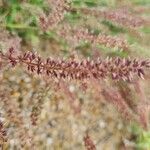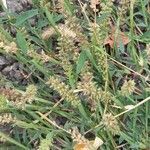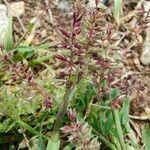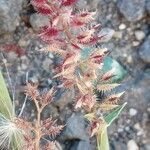Annual; up to 0.4 m high; culms usually decumbent; sometimes rooting at nodes. Leaf blades 20-60 x 2-4 mm. Flowers: inflorescence loosely spike-like; spikelets clustered on peduncles that are much shorter than spikelets; lowest in each cluster 3.5-5.0 mm long; upper glume 7-nerved; spaces between nerves ± same width as nerves; glume spines hooked at apex; anthers 0.6-0.8 mm long.
Annual 110-400 mm high, culms usually decumbent. Leaf blade 20-60 x 2-4 mm. Inflorescence 25-100 mm long, loosely spikelike; spikelets clustered on peduncles much shorter than spikelets. Lowest spikelet in each cluster 3.5-5.0 mm long; upper glume 7-nerved, spaces between nerves about same width for entire length, bulbous-based spines hooked at apices; anther 0.6-0.8 mm long.
Annual, culms usually decumbent, up to 400 mm tall. Leaf blades 20-60 mm long, 2-4 mm wide. Spikelets (lowest in each cluster) 3.5-5.0 mm long. Inflorescence loosely spike-like; spikelets clustered on peduncles that are much shorter than spikelets; lowest glume 7-nerved, spaces between nerves ± same width as nerves; glume hairs hooked at tips; anthers 0.6-0.8 mm long.
Annual up to 25 cm tall, erect or geniculately ascending; leaf laminas 2–6 cm × 1.5–4.5 mm, flat or plicate, glaucous, the margins thickened, whitish, pectinate with bulbous-based hairs or barbellate.
Spikelets 3.2–4 mm long; superior glume prominently 7-nerved, the nerves bearing hooked, bulbous-based prickles, glabrous between the nerves; anthers 0.5–0.7 mm long.
Inflorescence 2.5–6 cm long, compactly cylindrical, congested; racemelets comprising (1)2–4 fertile and (1)2 sterile spikelets borne on a short peduncle.
A herb. It is an annual grass. It grows 25 cm high. The leaves have stiff hairs along the edge. The flowers are spiny. They are in spikes 7 cm long.
Annual, up to about 30 cm. high
